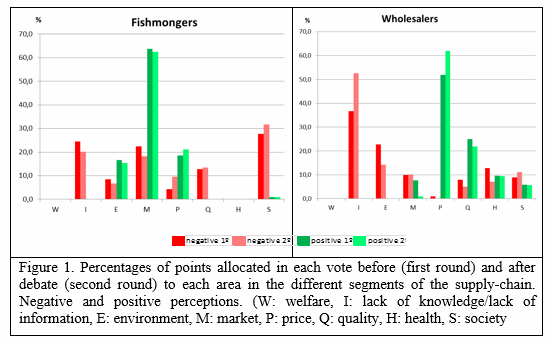SUPPLY-CHAIN AGENTS' PERCEPTIONS TOWARDS AQUACULTURE: A HYBRID DELPHI APPROACH.
Introduction and Objectives:
There are many studies that explore consumer's perception towards aquaculture, but studies focusing specifically on the supply-chain perception are scarce. Consumers' perceptions towards aquaculture could become a bottleneck for the sector's full development. Nevertheless, consumer's buying decisions are directly affected by their fishmongers' advice and by the availability of fish on the central markets. In this context the main objective of this paper is to describe the perception about aquaculture at two steps of the supply-chain, wholesalers (from Mercabarna, the central market of Barcelona) and retailers (fishmongers from different local markets of the city). Specifically, we determine which positive and negative perceptions do the fish traders derive from the products provided by the fish farm industry.
Methodology:
Methodologically, a qualitative study by means of a combined technique known as Hybrid Delphi (Landeta et al. 2011) was carried out. This method combines three qualitative techniques for group analysis: the Focus Group (FG), the Nominal Group Technique (NGT) and the Delphi method. The FG allows obtaining the less rationale and the more spontaneous information that usually is not obtained through questionnaires (Krueger & Casey, 2009). The Focus Groups were implemented introducing the NGT. This method is oriented to the generation of ideas and their ordering (ranking). Participants are asked to provide any idea they have about the positive and the negative aspects of aquaculture. All this aspects or ideas are shown in a screen. Once this is finished, and without any discussion, participants are given 15 points to allocate to their five most important ideas (5, 4, 3, 2 and 1 points from the most important to the least). Afterwards, there is a debate where all participants can argue in favour or against any of the ideas written on the screen. Later, a second round of votes is performed. All sessions are videotaped for its further transcription and analysis. Two groups of fish distributors (7+7) participated in this study. The groups were defined by their professional activity. Thus, there was a first group of wholesale distributors and a second group of fishmongers or retailers. The following stage of our research is implemented by the Delphi method (Phil, J. 1971). The Delphi questionnaire was designed from the results of the first stage of our study, which are shown on the Results section. The results from the Delphi method are still under investigation.
Results:
The group of retailers (fishmongers) found that the most positive aspects of aquaculture are the availability of the product all year round (29.8% of the points), and the high variety of the supply (species, qualities, prices…) (28.8%). The most negative aspects were the lack of consumers' trust in aquaculture and their rejection of its products (31.7%). As second choices, the lack of consumers' knowledge (20.2%) and, that aquaculture allows the large retail sector competing better with low prices due to its scale economy (18.3%)
The group of wholesalers value as the most positive aspect their comfort when buying aquaculture products: the products are always available and at good prices and (28.6%). Secondly, and in a second post with a similar score (17.1%-16.2%): price stability and democratisation of fish consumption. As the main negative aspect they pointed out the consumer's lack of knowledge on all aspects of aquaculture (feeding, treatments, genetic modification, etc.) (52.5%). Comparing both rounds of votes, for each question and in each group, differences of the number of points allocated to the items were obtained. The higher difference after the debate was found in the wholesaler group for the consumer lack of knowledge (36.6 to 52.5% on the second round). All questions arisen can be allocated to several area identified for the frequency of their appearance in the sessions (W: welfare, I: lack of knowledge/lack of information, E: environment, M: market, P: price, Q: quality, H: health, S: society), see figure 1. Market is more important for fishmongers and price for wholesalers. Quality aspects are not so important and are positive for wholesalers. Welfare is not a concern and environment is only a concern for wholesalers.
Conclusions:
The perception of aquaculture by consumers is not completely positive or negative, but depending on the aspect considered, and with some differences between the two groups. There is a common agreement that there is a society lack of knowledge and need of information on aquaculture subjects. For both segments of the supply chain the market/prices issues are important, but market is more important for fishmongers, closer to the final consumer, while price is more important for the wholesalers. The debate can change the perception in the different segments of the supply chain, so could do the provision of information based on scientific data if given in a friendly format.
We appreciate the cooperation of Mercabarna (the Barcelona wholesale market), the Wholesalers association from the Central Fish Market of Mercabarna, and the Retailers Fishmongers' association of Catalonia.
References:
Krueger, R.A. y Casey, M.A. (2009). Focups groups: A practical guide for applied research (4th edition). Thousand oaks, CA: Sage Publications.
Landeta J., Barrutia J. y Lertxundi A. (2011). Technological Forecasting and Social Change, Volume 78 (9).Pages. 1629-1641.
Pill J. (1971). Socio-Economic Planning Sciences, Volume 5, Issue 1, February 1971, Pages 57-71, ISSN 0038-0121, http://dx.doi.org/10.1016/0038-0121(71)90041-3.
